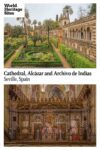Cathedral, Alcázar and Archivo de Indias in Seville
By Cindy Carlsson.
What is the Seville Cathedral, Alcázar, and Archivo de Indias World Heritage site?
The Seville Cathedral, Alcázar, and Archivo de Indias UNESCO site includes three properties located in the heart of Seville, Spain:
- The mostly Gothic 15th century Cathedral and its much older Islamic/Renaissance tower;
- A royal palace that began as an 11th-century Islamic palace;
- The Spanish-Renaissance former Consulate of the Merchants of Seville, which houses records of Spain’s 16th and 17th-century activities in the Americas.
Together these sites tell the story of Seville from the final days of Islamic rule through the end of the Spanish Golden Age in the 17th century.
Disclosure: This article contains affiliate links. Making a purchase through an affiliate link will mean a small commission for this website. This will not affect your price. Privacy policy.
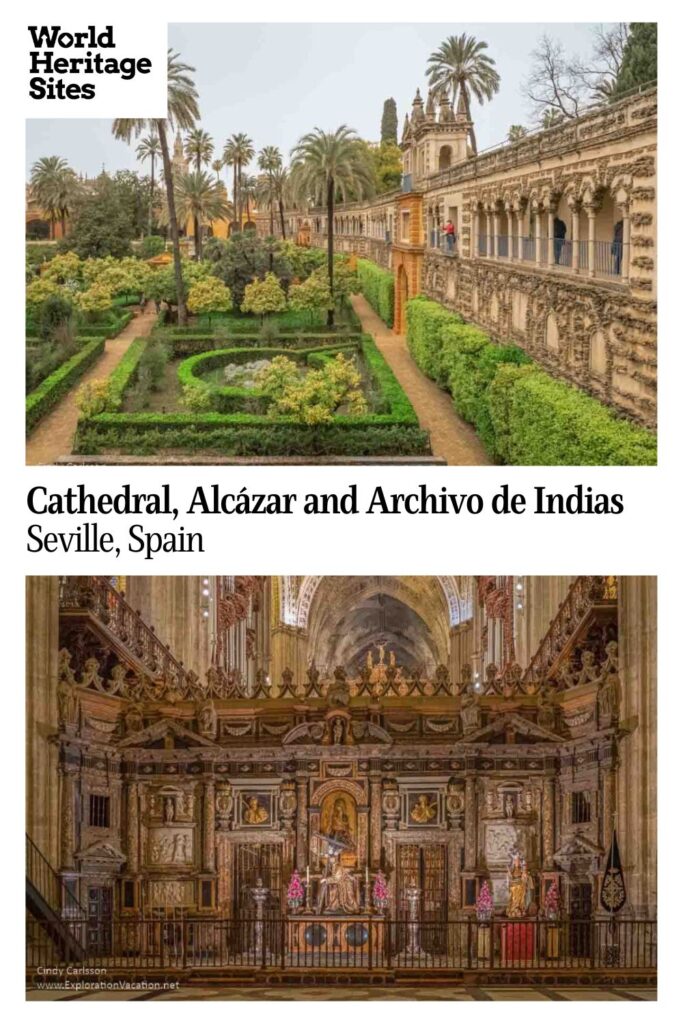
Why are the Cathedral, Alcázar, and Archivo de Indias in Seville a UNESCO World Heritage site?
The three properties that make up the Seville UNESCO World Heritage site seem to be important more for the stories they tell about Spanish history than the architecture itself. Not that there isn’t some impressive architecture to enjoy while learning that history.
UNESCO summarizes it thus: “Together the Cathedral, Alcázar, and Archivo de Indias as a series, form a remarkable monumental complex in the heart of Seville. They perfectly epitomize the Spanish “Golden Age”, incorporating vestiges of Islamic culture, centuries of ecclesiastical power, royal sovereignty and the trading power that Spain acquired through its colonies in the New World.”
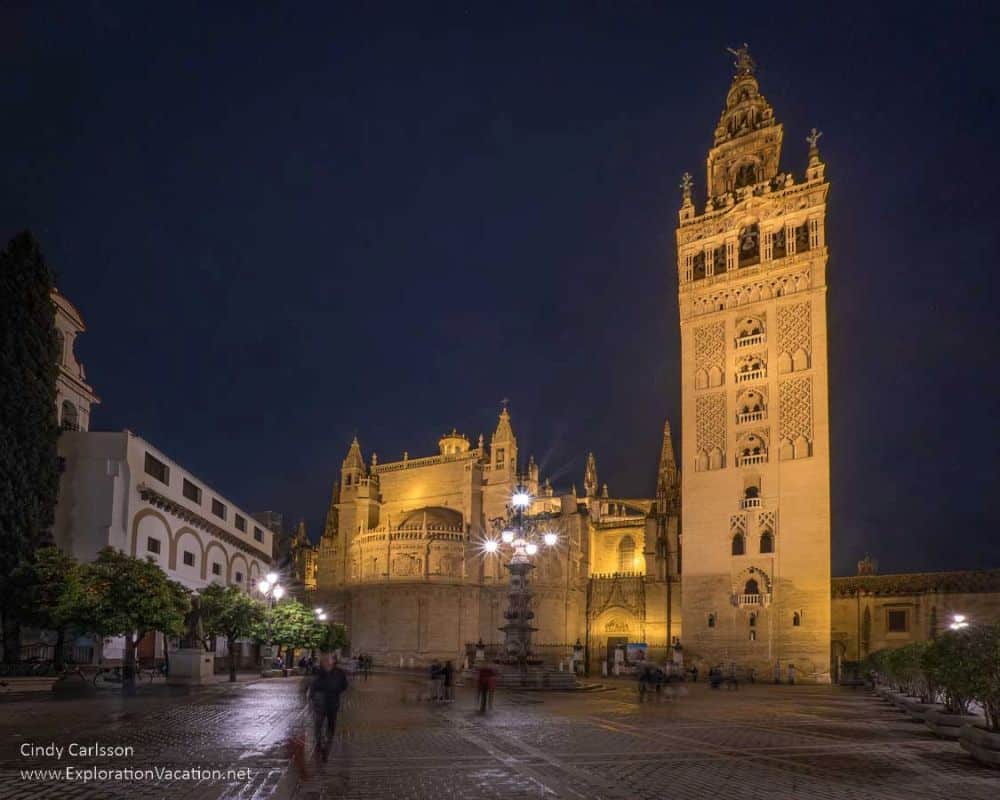
What can you expect on a visit to these sites in Seville?
All components of this World Heritage site are adjacent properties in the historic heart of Seville.
Cathedral of Seville
The Cathedral of Seville, formally the Catedral de Santa María de la Sede (Cathedral of Saint Mary of the See), is the largest Gothic church in Europe and one of the largest Christian churches in the world. It also documents centuries of Spanish history.
It’s built on the site of a reconfigured Almohad mosque that served as Seville’s cathedral after the Reconquista in 1248. City leaders decided to build a new cathedral on the site in 1401. Legend says they wanted to build a church so beautiful and grand that anyone who saw it would think them mad. They seem to have met that goal, even if it took more than a lifetime to complete.
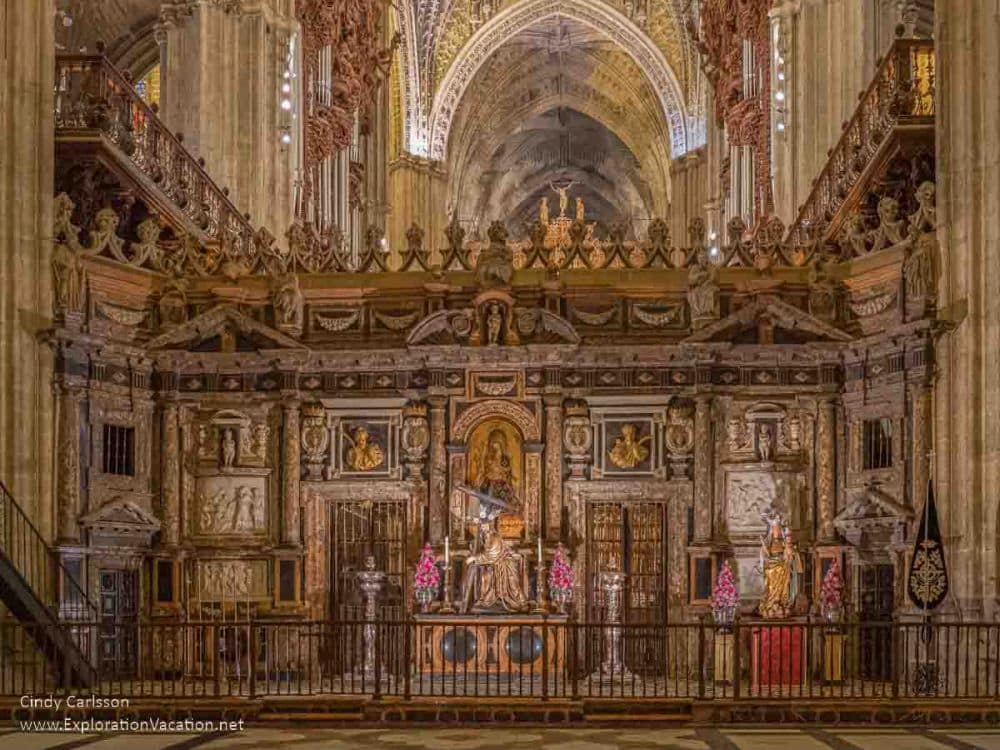
Stepping inside for the first time, you’re likely to be struck first by the cathedral’s size. Pools of darkness fill the open spaces that separate chapels from the enormous central altar, choir, and pipe organs. It’s more like walking a city street at night than walking through a church. But as you follow the light around the building, you’ll discover it’s filled with precious gold and silver objects and fine paintings that testify to the wealth Seville extracted from the Americas and kept for itself.
The main altarpiece of carved and gilded wood has hundreds of carved figures (some say more than 1000) and stands almost 30 meters/100 feet high and 20 meters/65 feet wide, making it the largest Christian altar in the world.
Chapels and tombs, including the Royal Chapel and the tomb of Christopher Columbus, line the outer walls.
Most, but not all, of Seville’s Cathedral is Gothic. Among other additions, a few fine Renaissance spaces, particularly the elegant elliptical Chapter House (Cabildo), provide a bit of architectural contrast.
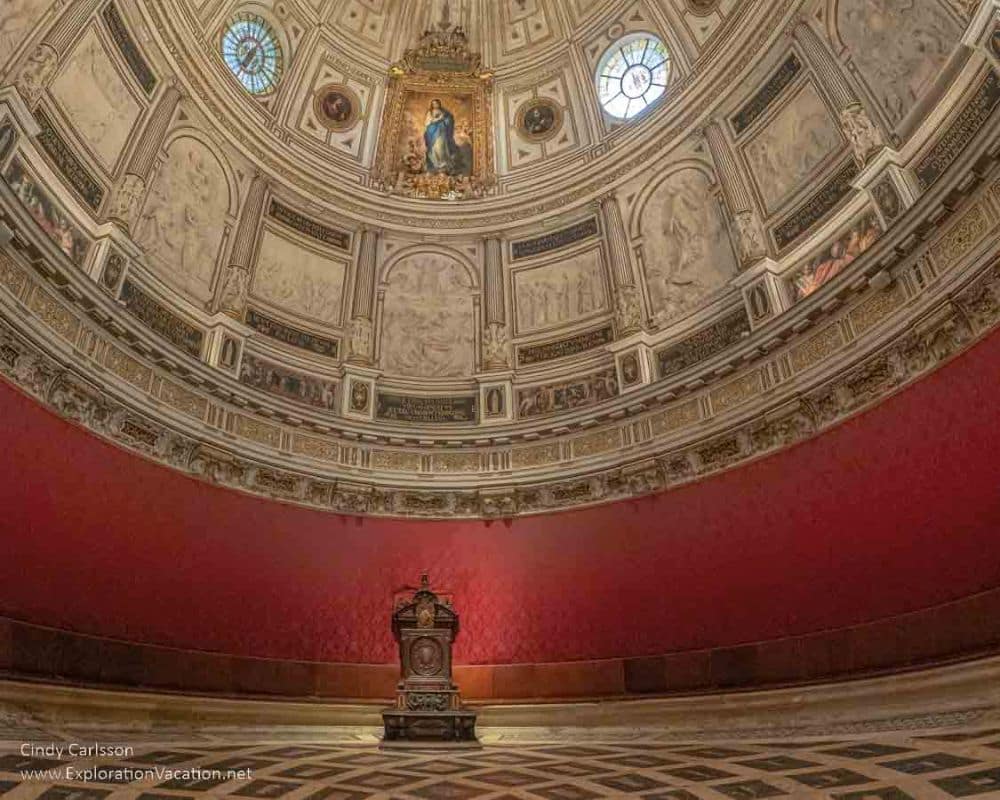
Other bits of architectural contrast are found in the remains of the mosque: the Patio de los Narajos (Patio of the Oranges) and the Giralda Tower. Of these, the Giralda Tower is the most significant. Originally a minaret, it was converted into a bell tower when the mosque first became a cathedral. The top got a Renaissance update, but otherwise it’s pretty much the original Almohad minaret. At more than 100 meters/340 feet in height, the relatively easy-to-climb tower offers outstanding views of Seville.
Skip-the-line tickets for Seville Cathedral and the Giralda Tower.
Alcázar
Seville’s Royal Alcázar isn’t as large and beautiful as the Alhambra in Granada, but it is impressive. Said to be the oldest royal palace still in use today, it was constructed in the 11th century as the region’s Islamic royal palace and center of government. It was greatly expanded in the 12th century, and then rebuilt in Mudéjar (Spanish Muslim) style in the 14th century as a royal palace for Spain’s Christian rulers. Along the way, the complex also received Gothic, Renaissance, and 19th-century modifications. But it’s the elaborate Mudéjar-style architecture that wows most visitors.
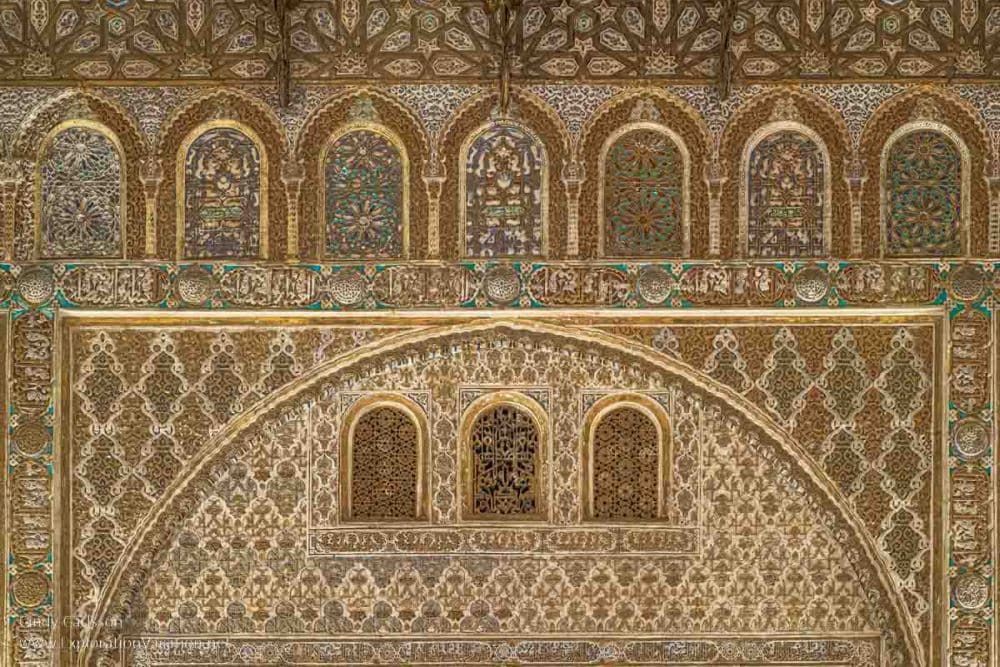
The Alcázar also has extensive gardens in a variety of styles. These have changed since the Islamic period, but pleasure gardens and fountains, as well as gardens for food production, have been on the site throughout its history.
But more than the architecture itself, UNESCO seems interested in the Alcázar’s role as a royal residence from the Islamic period that still serves as a royal residence today. That, and the fact that the Alcázar includes the Admiral’s Hall, an otherwise rather ordinary room in the historic House of Trade that was used to plan global expeditions and manage trade during Spain’s Golden Age.
Skip-the-line tickets for the Alcázar.
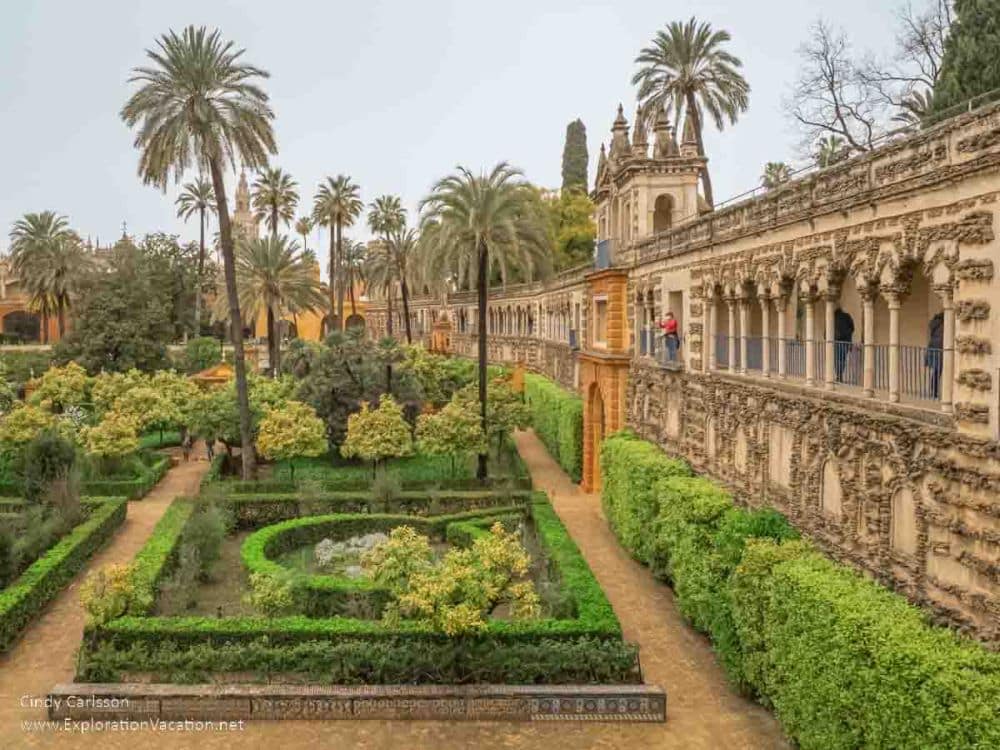
Archivo de Indias (Archive of the Indies)
By the 16th century, Spain’s control over the newly-colonized lands in the Americas made it the richest and most powerful country in Europe. Seville was the center of that activity for much of the Spanish Golden Age, but documents recording that activity were stored in various cities around Spain. In 1785, the 16th-century Consulate of the Merchants of Seville became the archive for all documents related to Spain’s activities in the “New World.”
The building itself is a significant example of the Spanish Renaissance style that influenced the Baroque architecture built in the Americas. But its real importance lies in the documents it holds. 43,000 files containing some 80 million pages of documents on 9 km (over 5 miles) of shelving record Spain’s activities related to the Americas. These include everything from cargo logs to maps, city plans, ship designs, illustrations of the people and plants of the Americas, and so much more. Columbus’ letters to Isabella and Ferdinand are here, as is the 1494 treaty that divided the world between Portugal and Spain.
While this may all sound rather dry, the Archive of the Indies has some fascinating exhibits that fill the large gallery spaces with historic documents, artifacts, models, videos, and more. Exhibits might include the design of ships in the Spanish fleet, port plans, the life of a sailor (complete with furious storms and a shipwreck that you are included in), plant samples from the Americas, and pretty much everything in between. Unfortunately, almost none of it includes information in English.
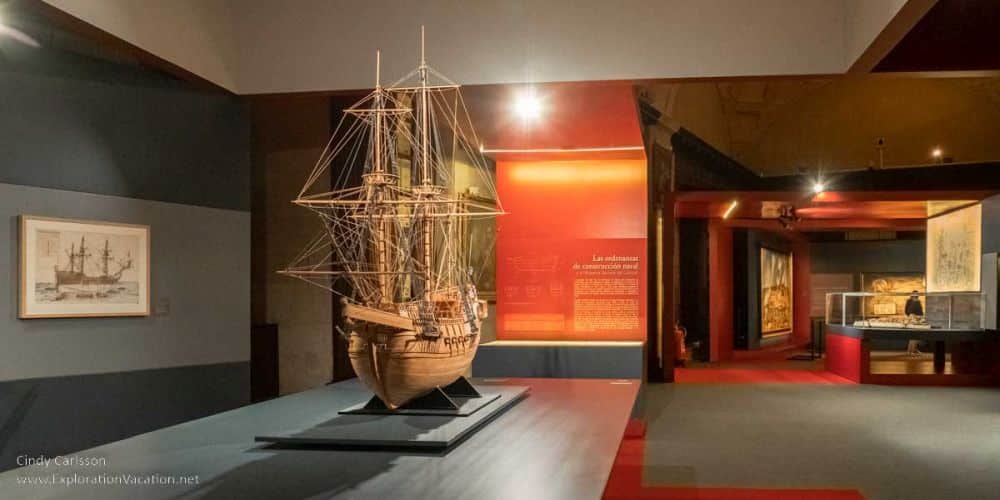
Is the Seville UNESCO site worth visiting?
Seville itself is a particularly pleasant place to spend time. So, while you could visit the Alcázar in the morning, the cathedral at midday, and the archive in the afternoon, two or more days lets you really explore Seville’s World Heritage site and see a little more of the city.
Book your accommodations in Seville.
The Alcázar itself is worth traveling a long way to see, as much of its architecture is unique to southern Spain. And, while you’re in Seville, it’s very much worth visiting the cathedral and archive as well.
Seville’s Alcázar has some spectacular spaces. Plan to spend most or all day here if you want to see the entire site. But even if you stick to the highlights, plan to spend at least two hours here. Three or four hours is probably more realistic for most visitors, especially if you are visiting the apartments used by the current royal family. Add more time if you are very interested in architecture or gardens.
The Cathedral of Seville has some amazing spaces and lots of precious art. It’s interesting, but unless you are very interested in seeing Columbus’ tomb or Spanish religious art and architecture, it isn’t that different from other Andalusian cathedrals of the same era. You can take a quick look at the highlights and climb the Giralda tower in about an hour. Allow two hours or more to also look at more of the chapels and visit the museum and chapter house.
You’ll find the exhibits in the Archive of the Indies fascinating if you have any interest at all in the Spanish Golden Age or Spanish exploration / colonization / exploitation of the Americas. Sadly, there are no translations for most informational signage. However, even if you can’t read Spanish and don’t think any of this sounds very interesting, set aside a half-hour just to take a quick look. You’re very likely to find something that interests you. For those of you who already know you’ll find something interesting, plan to spend a couple of hours here even if you can’t read Spanish.
Visitors interested in seeing more of Spain’s Islamic and Mudéjar sites should consider a trip that combines Seville with UNESCO World Heritage sites in Córdoba (including the nearby ruins of Medina Azahara) and Granada. Fans of architecture in general should also add Úbeda and Baeza to their itinerary.
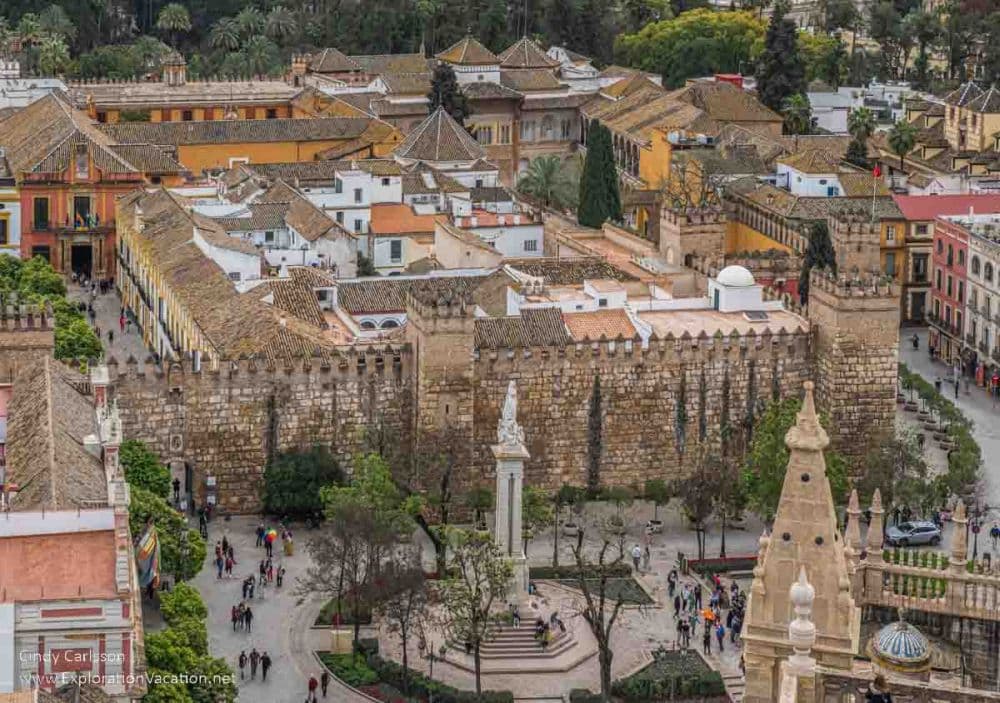
What sorts of travelers would like the Seville Cathedral, Alcázar, and Archivo de Indias World Heritage Site?
Travelers interested in architecture or Spanish history will find lots to like at Seville’s World Heritage site.
None of the places included in this World Heritage site seem particularly child-friendly. Children visiting Seville’s Cathedral are more likely to enjoy a trip to the top of the tower than the dark and quiet cathedral where most things are behind gates. The Archive of the Indies may have a few exhibits that would be fun for kids, but most of it isn’t child-friendly. (Even if your 8-year-old loves maps with sea monsters on them or model ships, they probably aren’t tall enough to see into the adult-level display cases.) And, at the Alcázar, the most interesting areas are always very crowded and only low-hanging ropes separate young children from off-limits rooms, gardens, and pools.
Tips for visiting these Seville World Heritage sites
Buy your ticket for the Alcázar well in advance of your trip. Tickets are limited and can sell out during summer and other peak periods. And, even when tickets are available, the line can be very long.
Tickets that include a guided tour of the royal family’s quarters in the Alcázar don’t cost a lot more and give you access to spaces most visitors don’t see. However, you may find your ticket – which includes entry to the rest of the Alcázar – cancelled on relatively short notice if a change of plans brings the royal family to Seville when you plan to visit. Book a new ticket for the rest of the site immediately! (It would be nice if they’d just cancel the part of the ticket that covers the royal quarters, instead of making you rebook the entire visit. But they don’t.)
You can spend as much time as you want at the Alcázar, but after a certain point it becomes a one-way route. Take your time and see everything that interests you as you go. Don’t think you’ll come back and take another look later, because you might not be able to.
Skip the line for tickets to the Cathedral of Seville by buying them at Iglesia del Salvador (the Church of the Divine Savior) or buy them online in advance. There’s never much of a line and the short walk between the two is pleasant enough. While there, go into the Salvador Church, as it is also well worth visiting and is free with your ticket for the Seville Cathedral.
The climb up Giralda Tower is pretty easy, with ramps that replace most steps. And it’s wide enough to ride a horse up, so not really claustrophobic. But bring ear plugs if you are sensitive to loud sounds, as the bells are right above your head when you get to the top and they seem to ring frequently.
Visitors are welcome at the cathedral’s daily mass. You’ll get to hear one of the pipe organs during the service, but you are not allowed to wander around or take pictures during mass.
Where are the Seville UNESCO sites?
Seville is in Andalucía in southern Spain.
Direct flights are available from many cities within Spain as well as internationally. It takes 1½ hours to fly to Seville from Barcelona or an hour from Madrid. From Amsterdam it’s about a 3-hour flight. It’s about 2½ hours coming from either Paris or London.
Seville is also well connected to the rest of Spain and all of Europe by rail. Travel to Seville from Barcelona by high-speed train takes about 5 hours. It’s about half that time if traveling from Madrid.
Driving between Madrid and Seville takes slightly longer than the fastest train.
The three components of the Seville Cathedral, Alcázar, and Archivo de Indias UNESCO World Heritage site are located next to each other in the historic heart of Seville. They are clearly identified on Google maps and, once you are in Seville, the Giralda Tower is visible from many places all over town.
Some of the most popular areas for tourists to stay in Seville are within easy walking distance of Seville’s World Heritage sites. But the area where these sites are located is also well served by local transit, including many bus routes. Parking garages are available nearby, but driving in the heart of Seville is a hassle and parking is expensive.
For more information, including opening hours and admission fees, see the official website for each separate component of the Seville Cathedral (in Spanish – use Google translate), Alcázar and Archivo de Indias (also in Spanish).
Have you been to Seville and seen the cathedral, the Alcázar and/or the archive? If so, do you have any additional information or advice about this UNESCO World Heritage site? Please add your comments below!
Cindy spent several days exploring Seville’s incredible World Heritage sites. At the same time she marveled at their richness, she says these sites were overwhelming in size, scope, and the richness of the materials in them. Of course, that was the intent, as the builders wanted the world to be awed by the wealth and power they held.

